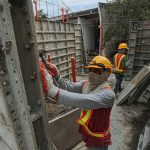Surety Bond Professionals is a family owned and operated bonding agency with over 30 years of experience. With access to a broad range of surety markets, our expert agents are ready to assist with all of your construction bond needs.
Time Is Money
There are few industries in which the old saying, “Time is money” holds as true as it does in construction. Construction delays can have a significant impact, which raises immediate concerns about how long, how much, what went wrong, and who’s responsible. The answers to questions like these are not always clear-cut, and thorough analysis may be required to resolve delay claims—a process referred to as forensic delay analysis.
Critical vs. Non-critical Activities
The starting point is determining whether the delayed activities are critical or non-critical. That determination is based on how many days an activity can be delayed (the “float”) without delaying the entire project. Critical activities have zero float, meaning a delay of even one day will delay the whole project. Non-critical activities only become critical when a delay exceeds their float.
Common Causes of Construction Delays
Causes of construction delays generally fall into these categories:
- Contract errors or omissions (e.g., missing, incorrect, or conflicting information, etc.)
- Delays caused by contractors for reasons under their control (e.g., inadequate crew size, cash flow problems, poor planning, etc.)
- Delays for reasons beyond a contractor’s control (e.g., strikes, subcontractor default, supplier bankruptcy, natural disasters, etc.)
- Delays caused by owners for reasons under their control (e.g., scope changes, cash flow problems, lack of site access, etc.)
- Delays caused by project team conflicts (i.e., conflicts and finger pointing between team members)
Delay analysis may be complicated by the fact that multiple factors may have contributed to a delay.
Delay Analysis Goals
A key goal of critical delay analysis is to determine whether a delay is excusable (not the contractor’s fault) or non-excusable (the contractor’s fault). In the case of an excusable delay, the contractor is owed a time extension. Delay analysis also determines whether a delay is compensable (money is owed to the delayed party as compensation for the financial loss resulting from the delay) or non-compensable (a time extension is granted to the delayed party, but no compensation is owed). The ultimate goal, of course, is to resolve all delay claims and get the project back on track, if possible.
Delay Analysis Method
There are several commonly used delay analysis methods, each with advantages and drawbacks.
As-Planned vs. As-Built Method
This is an observational method in which planned activities are compared to the actual sequence of activities from the beginning of the project. The variances between planned and actual activities are identified and associated delays are quantified. Observable variances include such issues as late starts or extended duration. This simple method is best for simple projects of short duration with a consistent critical path. It’s typically not as accurate for more complex projects.
Impacted As-Planned Method
This method uses scheduling software to insert excusable events (those for which the contractor is owed a time extension) impacting the delay into the original as-planned schedule to determine how those events affected the project completion date. Comparing the as-planned completion date to the impacted completion date allows quantification of the days of delay resulting from those delay events. The primary drawbacks of this method are that it ignores shifts in the critical path and produces results that are hypothetical in nature.
Collapsed As-Built or “But for” Method
This method aims to determine the completion date if the excusable impact events had not been included. They are removed from the final as-built schedule and the schedule is rerun through the scheduling software to calculate the difference between this modeled completion date and the actual completion date and quantify the associated delay. The results of using this method are theoretical and heavily influenced by the decisions made in removing impact events from the as-built schedule.
Time Impact Analysis Method
This backward-looking approach quantifies each delay event before and after the event is added to the most recently updated schedule. The amount of delay is calculated based on the difference in project completion date between the non-impacted and impacted schedule. This method is only used when there is reliable data for each event. And it can be overly cumbersome when there are many delay events to account for.
Window Analysis Method
In this approach, the total project duration is divided into shorter “windows” for analysis, typically between one and six months long. Delay is quantified for each window by measuring activity late starts and extended durations. After such updating, the as-planned schedule for a given window becomes an as-built schedule up to that window’s end date. This method offers the advantage of considering changes in the critical path, but it requires detailed project records and can be time consuming.
Final Thoughts
Late project completion due to non-excusable contractor delays may be grounds for a performance bond claim on the basis of breach of contract. All contractors should have a basic understanding of construction delay analysis and be committed to timely completion of each project.
Call Us Today
Our surety bond professionals will help you grow your revenue by maximizing your surety capacity. Call us today!





